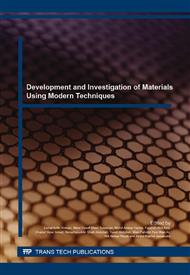p.236
p.240
p.247
p.252
p.257
p.262
p.267
p.271
p.276
Morphology, Thermal and Chemical Properties of Nanocrystalline Cellulose (NCC) Hydrolyzed from Banana Stem
Abstract:
Banana stem (BS) was used as the natural cellulose source. It must undergo an alkali treatment and bleaching process before continuing with an acid hydrolysis. Then, the Nanocrystalline cellulose (NCC) was synthesized via acid hydrolysis with four different concentrations of sulfuric acid (H2SO4) at 50 %, 52 %, 54 % and 56 % respectively at 50 0C for 1 hour. The influence of acid concentration of morphology, thermal and chemical properties of the NCC was studied in this project. The morphology dimension of the NCC was determined by using field emission scanning electron microscope (FESEM) and thermal stability of the NCC was determined by using thermal gravimetric analysis (TGA). Chemical composition and structural analysis were measured by using Fourier transform infrared (FT-IR) and X-ray diffraction (XRD).
Info:
Periodical:
Pages:
257-261
Citation:
Online since:
January 2016
Authors:
Keywords:
Price:
Сopyright:
© 2016 Trans Tech Publications Ltd. All Rights Reserved
Share:
Citation:


